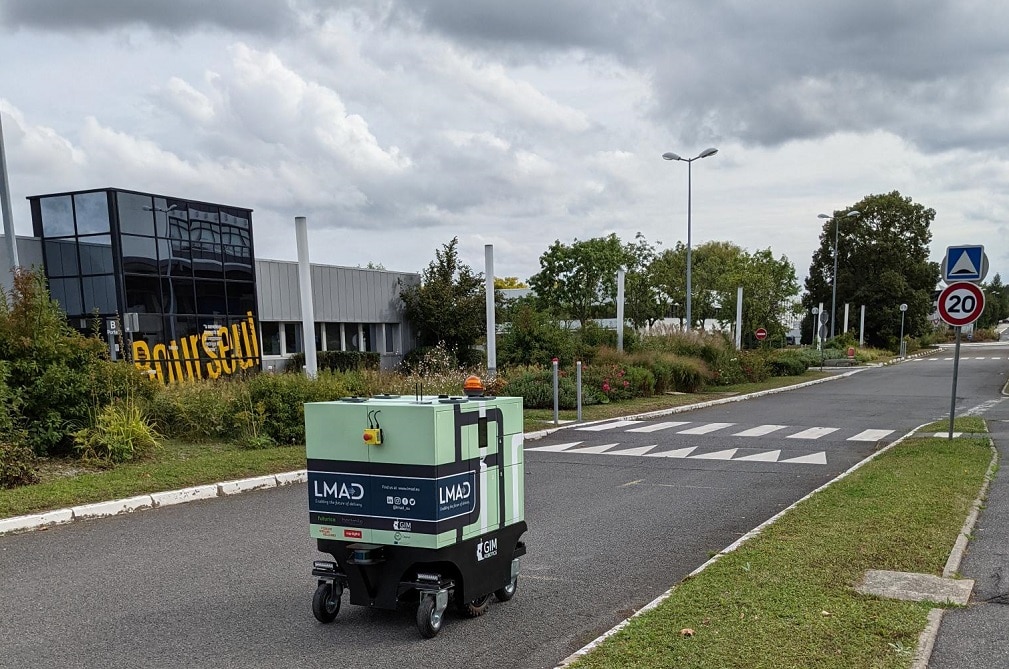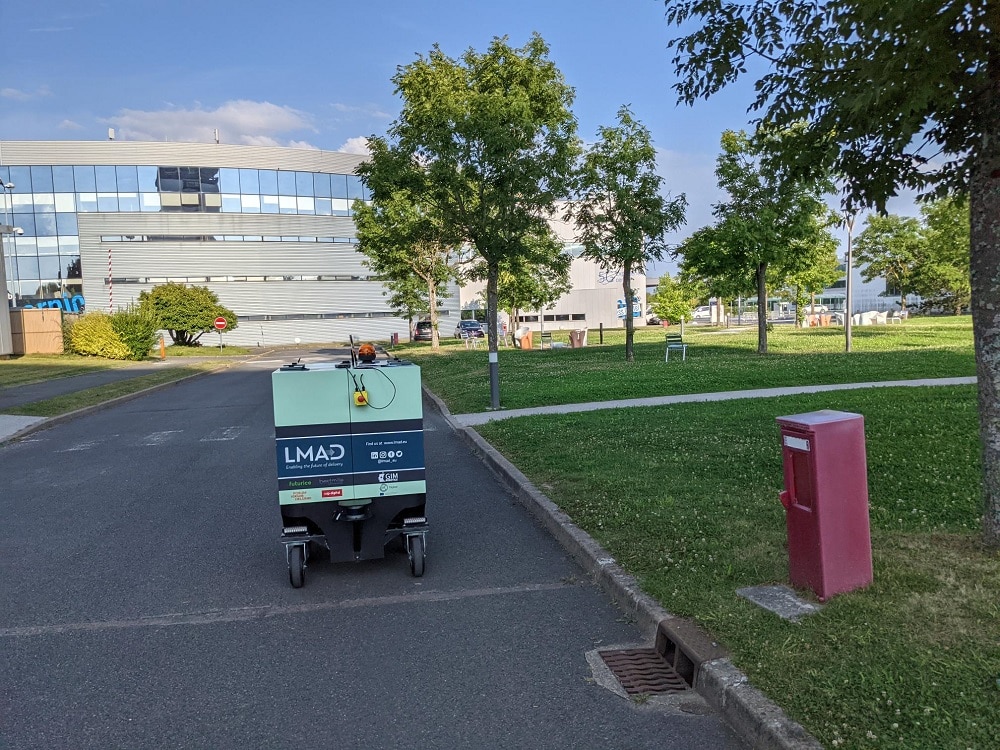LMAD is testing an autonomous delivery robot (ADR) for parcel deliveries at a Nokia Campus in France
Timeframe: November 2019 to December 2021, with a possible extension into 2022
Partners: Nokia, Sodexo, GIM Robotics
Focus: On-site autonomous parcel deliveries to Nokia’s employees at an industrial R&D campus
Location: Nokia Paris-Saclay Campus (near Paris, France)
On-site employees: 2500 to 3000
Number of delivery locations: 15
Robot: An autonomous delivery robot (ADR) developed by GIM Robotics

LMAD is currently working on an experiment for on-site autonomous parcel delivery at the Nokia Bell Labs Paris-Saclay Campus.
Our platform handles the last mile segment of the delivery process automatically, from A to Z. The goal of this experiment is to provide a comprehensive proof of concept for autonomous delivery at an industrial site, and also to provide Nokia with a viable and cost-efficient on-site delivery option for small parcels (under 5 kg). Currently, we’re in the test phase of the experiment, with expected deliveries by the end of 2021.
In this article, we’ll discuss the experiment’s context, goals, and challenges, and look at what we’ve achieved so far.
The experiment’s context and goals
Before starting to work on this project, we were in touch with the Nokia Bell Labs team, the R&D subsidiary of Nokia. Everything began with Nokia’s 5G Days in November 2019, an event where Nokia showcased a number of use cases and demos for 5G technology. Our autonomous robot was one of the demos that were presented, and this was an occasion to complete one autonomous trajectory in front of the 5G building.
We were also hosted at Nokia’s Le Garage, a start-up incubation and acceleration space that aims to connect and catalyze innovative projects.
Since then, we’re building a strong automated delivery process from the ground up at the Nokia Bell Labs Paris-Saclay Campus. It covers the last mile of parcel delivery: from the receipt and acknowledgment of the parcels at the local depot to the delivery at the employee’s building, all without a human in the loop—if not to watch the robot for safety purposes.
Because of Covid-19 and different project constraints, we weren’t able to progress as fast as we had initially foreseen, but for the last 2 years, we’ve done a lot of testing and improvements to our platform, and made significant progress in terms of operational knowledge and efficiency.
We’re aiming to begin deliveries to Nokia’s employees by the end of the year (2021) and to provide Nokia with a viable proof of concept of on-site autonomous deliveries at an industrial R&D campus.
The use cases
The main use case is for B2B autonomous parcel delivery at Nokia’s campus.
Autonomous parcel delivery
At the campus, there’s a warehouse depot that serves as a consolidation point for all parcels, and which is operated by Sodexo. Currently, big parcels are delivered to campus locations with a delivery van, while small parcels (under 5 kg) are collected by employees at the warehouse. This means that employees need to walk or drive there, which is disruptive and takes time and effort.
We aim to start delivering these small parcels to employees with the help of our autonomous robot, as they fit in the locker compartments. At the moment, there’s no service available to cover this need.
This will facilitate parcel deliveries for employees, making them significantly more convenient to users, while also providing a cost-efficient solution to Nokia’s use case.
The robot will eventually function without a safety driver nearby.
The experiment
Currently, we’re in the process of testing our autonomous on-site delivery solution; most of the flow is now working but there are occasionally edge cases we need to cater for.
Our goal is to be fully operational and deliver parcels to end users before the end of the year. At the moment, we have started the onboarding process with a few users who showed interest in participating in the experiment.
There are 15 pickup locations, as some of the buildings are big and have a few entrances. We are currently testing deliveries to a few locations, and we’re aiming to gradually expand to the whole campus.
The number of deliveries per day
The pre-Covid numbers were of about 500 per month, sometimes up to 50-60 per day, of big and small parcels alike. There were about 300 monthly deliveries of small parcels.
We aim to propose 2 daily rounds, one in the morning and one in the afternoon. This should cover the campus’ needs, as the robot has 13 compartments of different sizes.
The robot’s features
At the Nokia Paris-Saclay campus, we have an autonomous delivery robot (ADR) developed and built by GIM Robotics for LMAD.
The robot has a navigation stack, developed by GIM Robotics, which includes:
- 360° Lidars
- A GPS system with a centimeter-level accuracy
There’s also an obstacle detection feature, which also uses Lidar to detect obstacles of any kind, such as:
- Walls
- Buildings
- Trees
- Pedestrians
- Vehicles, and more.
The system makes the robot stop in case there’s any danger of collision: when there’s an obstacle in front of the robot, the robot stops and waits for the obstacle to move, or for the safety driver to take over. We’re also currently working on an obstacle avoidance system.

LMAD’s robot at the Nokia Paris-Saclay Campus
Roundabouts
Roundabouts are another obstacle that the robot needs to overcome, and these tend to be quite challenging for robots in general. At the moment, we’re doing trajectory Teach-and-Repeat, i.e. we’re teaching the robot trajectories and then repeating them. If the trajectory goes through a roundabout, the robot can repeat it in the same way and at the same speed, and just stop if there’s a car coming. This is the way most autonomous shuttles and fixed-route autonomous services work at present.
Routes and trajectories
We have recorded in advance all routes between buildings, but we’re not recording every possible trajectory: as there are approximately 15 pickup locations, there’s a lot of possible variations. We optimize routes, though, with our route optimizer, which is an algorithm that decides how the robot should move between different locations. The algorithm will always choose the most direct route between locations.
The robot is exclusively driving on the streets and not on sidewalks.
The delivery process
The delivery process will be, as follows:
- Data input: Every time a small parcel is received, Sodexo’s staff inputs parcel data into LMAD’s web interface.
- Data processing & communication with the user: The parcel data is processed by our platform, which sends an email to the recipient to negotiate a time slot and a pickup location. For this, the recipient gets access to a web page, where they can select one of the proposed time slots in the upcoming days.
- Synchronization: Whenever they select a slot, the logistics provider (Sodexo) receives information about it in their application.
- Loading: Before the beginning of each round, the logistics provider needs to load the parcels into the robot, according to the information provided by the app on which parcels to load.
- En route: When the robot is fully loaded, it’ll leave at the exact time when the round is supposed to start.
- PIN code & delivery: Whenever the robot leaves, all recipients will receive PIN codes via text message, as well as an estimation of when the robot will arrive (ETA).
- Reception: Once the robot arrives, the recipient will be able to open their locker with the PIN code.
- Confirmation & proof of delivery: Both the end user and the logistics provider receive a message confirming the successful delivery of the parcel.
If the recipient is not able to meet the robot to collect their parcel (f.e. if they’re in a meeting), the robot will wait for a while, and then the recipient will receive a notification, asking them to choose another time slot.
The platform’s features
The platform has a number of features that support the use case of on-site autonomous delivery for industrial campuses:
- Seamless communication: It handles the communication with recipients via email to negotiate pickup times, as this is the least disruptive channel of communication for corporate users. If they don’t see the email (f.e. if it ends up in spam), then they’ll receive a text message.
- Flexibility: Pickup times and locations are flexible and can be readjusted. We’ll send a map to users, where they can see where the different pickup spots are located, and choose the most convenient one for them.
- Accuracy: We provide recipients with an accurate ETA and inform them that f.e. in 7 minutes they have to meet the robot to pick up their parcel.
- Synchronization & optimization: It synchronizes and groups deliveries, in order to deliver all parcels to a single location in one go.
- Fleet orchestration and mission management: We had a partner who had developed a fleet orchestration and mission management system, which optimized the route of the autonomous vehicle, dispatched it at the right time and to the right location. As we’re no longer working with them, we had to build our own solution for this, which is already proving to work well.
- Locker management: On the robot, there’s a tablet with a user interface, which is used to communicate with the recipient. With it, they can indicate that they want to pick up a parcel, type the PIN code and open the right locker.
Conclusion
This experiment is similar to the experiment we’re working on with EDF: in both, we are testing autonomous on-site delivery for industrial campuses, in order to facilitate deliveries to end users, and build and deploy a solution that is both cost-efficient and convenient. Due to legislative constraints regarding testing and deployment in public areas, private campuses are an ideal deployment ground for last-mile autonomous delivery solutions.

